Ijraset Journal For Research in Applied Science and Engineering Technology
- Home / Ijraset
- On This Page
- Abstract
- Introduction
- Conclusion
- References
- Copyright
A Review of Solid Waste Management Systems in Pune City
Authors: Kuril Swapnil S., Kolekar Kunal K., Dhekane Shivsharan B., Shinde Abhijeet R.
DOI Link: https://doi.org/10.22214/ijraset.2024.63451
Certificate: View Certificate
Abstract
Solid waste management is among the basic essential services provided by municipal authorities in the country to keep cities clean.. n. Due to industrialization, rural to urban migration and high growth rate of population have induced rapid urbanization in developing countries and obviously in India also. The per capita waste generation rate in India has increased from 0.2 kg to 0.6 kg per day in cities with population ranging from 1.0 lakh to 50 lakh; such a steep increase in waste generation within a decade. Pune is one of the fastest developing city, it generates total quantity of waste is about 1300 to 1400 metric tons per day. So, there is need of the proper waste collection, transportation route for prevention of environment form the hazardous waste disposal. Solid waste management all over world is looked as major challenge to civil bodies. Pune corporation has taken initiatives to collect, segregate and treat solid waste and system for handling around 1600 MT / day is operative. Composting, biogas and inert waste recycle are present mode of treatment. Praj Industries limited, Pune has taken the activity further to noticeable level and can integrate overall waste management activities so that from biodegradables, biodiesel, bio CNG, fuel ethanol and liquid manure can be safely produced The solid waste is increasing in Pune city due to growth of population, urbanization, higher per capita income and standard of living, changing lifestyle and food habits. The solid waste created by the household units, shops, restaurant and commercial units are higher. Government and Municipal Corporation must encourage local management through collection, transport and segregation and disposal of solid waste. Public awareness and segregation at source, rules and regulations related to solid waste will bring good change in solid waste management. This site suitability map presented in four suitability level such as highly suitable, moderate suitable, less suitable and unsuitable. The present research work to find out the suitable solid waste dumping sites using Geoinformatics approach for Pune Municipal Corporation (PMC)
Introduction
I. INTRODUCTION
A. Background and Motivation
Solid waste comprises unwanted and discarded materials from houses, street sweeping, and commercial and industrial operations. Increase in urban population and changing life styles lead to the generation of solid waste. Generally, solid waste is heterogeneous in nature such as mixture of vegetables, food items, paper, plastics, rags, glass etc. If solid waste is disposed off on land in open areas, then it causes a negative impact on the environment, ground water and on health. The Pune Municipal Corporation has planned to construct six more solid waste management plants having a capacity of 750 metric tons garbage per day, said officials. According to the Environment Status Report (ESR) for 2022-232100 to 2200 metric tons garbage is being generated in the city every day. India generates an enormous amount of waste, including municipal solid waste (MSW), industrial waste, hazardous waste, and biological waste. According to the State of India's Environment 2023 report, MSW generation in India is estimated to be around 150,000 tons per day (TPD).Highly populated areas of the city are beseiged with waste on open plots, at roadsides, feeder points and more, ranging from food to plastic, discarded packaging, thermocol and more. Increasing vehicles and dust pollution generated from residential areas are the major contributors of increasing RSPM in Pune city. According to the Water Supply and Sewerage departments of PMC, only 71% of the total generated sewerage in the city is treated.
Solid waste management is associated with controlling the generation, storage, collection, transfer and transport, processing and disposal of solid wastes in a manner that is in accordance with the best principles of sustainability. It includes all administrative, financial, legal, planning and engineering functions involved in the solutions. The growing volume of solid waste generated by communities is a concern for public health officials as well as for environmentalist. Pune city is a known for its scenic beauty, rich natural resources as well as several educational institutes. However, this cultural, aesthetic and knowledge base has also created dump just outside of the city area by depositing lakhs of metric tons of garbage, out of which 900- 1,200 tons comes every day.
Solid waste results from various sources including animal wastes, hazardous wastes, industrial, medical wastes, food wastes, mineral wastes etc. Urban solid waste includes domestic wastes, street sweeping, construction and demolition debris, sanitation residues, trade and industrial refuse and biomedical solid waste (CPCB, 2000). The burial of non-biodegradable end products which are difficult to treat has lead to the conversion of huge chunks of fertile lands into non-usable, poisonous landfills. Ultimately this leads to soil pollution, groundwater contamination and formation of highly toxic leachate.
Solid waste management is a major challenge in urban areas throughout the world. The problem of solid waste management (SWM) in India, in combination with rapid urbanization, population growth and unplanned development is worsening day by day. Solid waste management (SWM) is the most urgent need and one of major challenges of the present times. According to United Nations Development Programme survey of 151 mayors of cities from around the world, the second most serious problem that city dwellers face (after unemployment) is insufficient solid waste disposal (UNDP, 1998). Without an effective and efficient solid waste management program, the waste generated can result in health hazards with negative impact on environment. The serious situation in future may arise due to the toxicity of ecosystems and unavailability of dumping grounds to treat and manage such wastes generated in huge quantities due to population pressure.
The daily per capita generation of municipal solid waste in India ranges from about 100 g in small towns to 500 g in large towns. The solid waste generated in Indian cities has increased from 6 million tons in 1947 to 48 million tons in 1997 and is expected to increase to 300 million tons per annum by 2047 (CPCB, 2000). The smart waste management application with 100% door-to-door waste picking was designed and developed using IoT with web and Android technologies. there goal is to give a user-friendly application for household users, waste pickers, drivers and dumping station admins. An Android-based mobile application for users for dropping waste in dustbins. The drivers and waste pickers will also use the same Android application for the collection of waste and tracking the route of the ward wise. ( Patil and Gidde, march 2023).
Access to disposal at the doorstep develops an integral behavior that can be altered by providing proper doorstep MSW disposal infrastructure as an extension of the existing municipal solid waste segregation model. (Viraja bhat& Yogesh patil, 2021).Defining comparison between the two cities and how their local governments differ in how they charge fees for waste management, how they collect and segregate waste, how often they collect the waste and the extent of the coverage.(Daniella sohkhlet & Shekhar nagargoje,2020). The alkaline nature of the solid waste is responsible for the increase in soil pH (Goswami et al 2008). India is the second largest country in world, with a population of 1.21 billion, accounting for 18% of world’s population Daniella sohkhlet & Shekhar nagargoje,2020). retraces plastic waste streams in the city of Pune, identifies contributions by informal economy workers to the recovery, sorting and recycling of plastic waste and provides policy insights that aim to harness the environmental benefits of a more inclusive and productive waste management model. Related data were collected from June to July 2018 by researchers with the Kagad Kach Patra Kashtakari Panchayat trade union and the Solid Waste Collection and Handling (SWaCH) cooperative and were then validated at a city workshop in Pune in August 2018.(Harri Moora and Haeshad Barde,2018).
The study is all about the emergence and growth of solid waste management (SWM) in different part of the world. Identifying the good practices followed by different part of the world and Indian cities to have sound policy and program to be adopted by the municipal corporation in managing solid wastes.(Shiba Parhi,2015).
Gasification Technology is an efficient one as most of the solid wastes, irrespective of the sources and materials present can be gasified directly to obtain synthesis gas or producer gas having sufficient calorific value. The gas obtained can be used as fuel or can be utilized to generate electricity, even it can produce plethora of various petrochemical products. We have conducted a mathematical modeling and simulation study on a downdraft gasifier to highlight its potential in waste disposal problem for Pune city(Thakre and Nandi,2015).
The proposed work emphasizes on the assessment of detail process of solid waste management such as collection, storage, segregation, transportation, treatment and disposal by using Geospatial tools like RS, GIS and GPS. It may help in sustainable urban environment of Pune city, (Nitin Mundhe,2014). E-waste consciousness and disposal practices among residents of Pune city (Viraja Bhat, Yogesh Patil,2013) Existing Situation of Solid Waste Management (Mane T.T. and Hingane Hemalata N,2011).
Due to increase in population, industrialization, urbanization and growth, a significant increase in MSW generation has been seen especially since last two decades. SWM in India is becoming inherent problem of the communities as the current SWM practices are inefficient to do the needful practices and strict implementation of the legal measures. This process requires heavy expenditure and affects public health and environment. Rapid urbanization and industrial diversification has led to generation of hazardous waste. In general, per capita generation rate of MSW in India ranges from 0.2 to 0.5 kg/day (CPCB, 2004).
Population is rapidly consuming the once vast supply of natural capital, especially the resources of deep and rich agricultural soils, natural sources of groundwater, and biodiversity (Nancy Kanbar, 1999). There has been a significant increase in generation of solid wastes in India over the last few decades and reason is largely associated with population growth. The huge number of public and private organizations have emerged that have been working to collect, dispose and treat wastes generated in country at various places and also seeks to have huge investment and good expected returns.
There is much need to apply 3 R’s approach in order to cause minimum resource consumption and reduction in the dumping grounds with the help of latest technologies. The messages have to be made clear and conveyed to all about the wastes being full of wealthy resources. Empowerment of the poor and employment generation are also the major demands in developing countries like India and these can be fulfilled by the newly emerging waste treatment organizations. Pune city is known on the world map because of its scenic beauty and rich natural resources as well as its educational institutions. "Phursungi – Uruli Devachi" area is one of the most beautiful areas on Pune’s boundary where hundreds (about 900-1200 tons) tons of solid waste are dumped every day. All of this has accumulated in the past 20 years creating huge amounts of garbage.
This humungous amount of garbage includes degradable waste, plastic as well as dead animals (www.punegarbage.org). The present case study is based on such one of the largest and solid waste treatment plants located at Phursungi-Urali, Pune and also the recent issues that are associated with the overall handling with the solid wastes generated in the city. Efforts are made to put views of the company, civic bodies and also of the people living nearby the dump site.
B. Pune Municipal corporation (PMC)
Main cause of Solid waste is increasing in Pune city due to growth of population, urbanization, higher per capita income and standard of living, changing lifestyle and food habits. The solid waste created by the household units, shops, restaurant and commercial units are higher.
Around 2,200 metric tons per day of waste is generated in the city spread across 516 sq km and having a population of around 50 lakh.
From the pune municipal corporation official website. we studies that different types off solid waste managementare as follows :-
- Biomedical Waste
- Construction and Demolition Waste
- E-Waste Collection
- Sanitary Waste
- Garden Waste
- Waste Processing Plants
- Plastic Waste
C. Objectives
- The main objective of this present research work is to assess the Municipal Solid Waste Management system like collection, storage, segregation, transportation, processing and disposal of Pune city using Geospatial tools.
- It may aid in quick and useful decisions for the purpose of administration and planning for a sustainable urban environment.
- Understand different types of waste, their handling, storage, disposal requirements, and their potential effect on the environment.
- 160 trucks collect waste door-to-door collecting an average of 225-250 tons per day.
- Through an agreement with the Pune Municipal Corporation (PMC), more than 3,000 women workers provide door-to-door waste collection services to over 600,000 homes in the city.
- Transfer and treatment of waste, energy from waste and conservation of basic material.
- The enoromous quantity of solid waste currently disposed of land can be reduced by recovering material and energy from waste in a cost effective and environmental friendly manner.
D. Introduction to technique of reducing the solid waste are as follows:-
- Use a reusable bottle/cup for beverages on-the-go :-
To Reduce Plastic Waste. To Protect Yourself from Toxic Chemicals. To Improve Your Overall Health. To Track How Much You Drink. To Promote Plastic-Free Living. To Save Money. Because Water Tastes Better in Stainless Steel Water Bottles.
2. Use reusable grocery bags :-
By using a reusable shopping bag, you can decrease the resources used on plastic bag production and disposal and protect the environment from plastic pollution. At the same time, you can save money, look stylish, and enjoy a better quality of life.
3. Purchase wisely and recycle :-
You can reduce the amount of waste you produce by purchasing products that come with less packaging and/or come in packaging that can be recycled. helps conserve natural resources, protect the environment, save money, and reduces the need to develop additional disposal capacity.
4. Compost it :-
Compost is a mixture of ingredients used as plant fertilizer and to improve soil's physical, chemical, and biological properties. It is commonly prepared by decomposing plant and food waste, recycling organic materials, and manure. You can use your compost to build healthier soil, prevent soil erosion, conserve water, and improve plant growth in your garden and yard.
5. Avoid single-use food and drink containers and utensils :-
Single-use plastic products (SUPs) are used once, or for a short period of time, before being thrown away. The impacts of this plastic waste on the environment and our health are global and can be drastic. Single-use plastic products are more likely to end up in our seas than reusable options. Carry a reusable bottle. Take a reusable coffee cup. Avoid excessive food packaging. Bulk buying and refill shops.
E. Solid Waste Management process :-
The term solid waste management mainly refers to the complete process of collecting, treating and disposing of solid wastes. In the waste management process, the wastes are collected from different sources and are disposed of. This process includes collection, transportation, treatment, and disposal of waste.
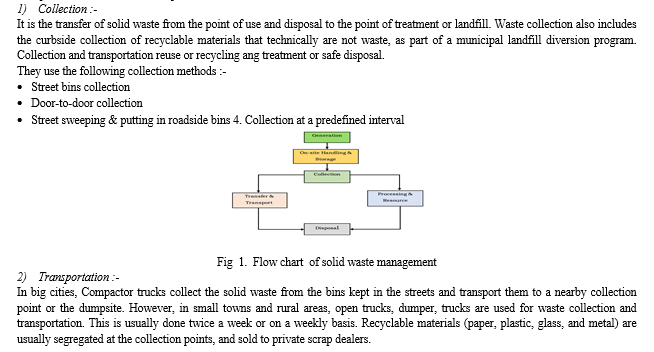

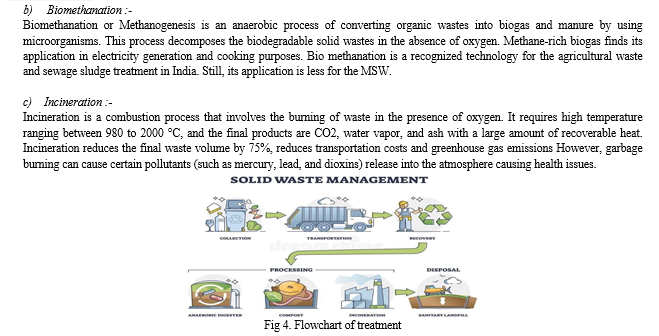
II. LITERATURE REVIEW
- Prof. Sangram, et al.,(2023) “Smart Waste Management With 100% Door-To-Door Waste Collection” :-
The management of solid waste is an issue that concerns everyone in the globe. Waste and consumption management decisions made by individuals and governments have an impact on the everyday health, productivity. Poorly managed waste is harming wildlife that consume waste unknowingly, polluting the oceans, cluttering drains and causing flooding, breeding disease-carrying vectors, increasing respiratory problems due to airborne particles from burning waste, affecting economic development through decreased tourism, and more. There is an urgent need for action at all levels of society to address the unmanaged and badly managed trash from decades of economic growth.The community's rubbish is piled up and the public rubbish bins are overflowing as a result of the increasing amount of waste, which not only make the neighborhood's streets smell unpleasant but also has a negative effect on the environment and public health.
2. Prof. Viraja Bhat, et al.,(2021) “An Integrated & Sustainable Model For E Waste Management In Pune” :-
Pune is one of the proposed smart cities and has been in the news due to the solid waste treatment challenges due to the treatment sites and infrastructure. With municipal solid waste, e-waste collection and treatment at the regular treatment facilities, not equipped to handle e-waste leads to untreated e-waste parts in whole or in traces. Lack ofawareness and non-segregation at source, inadequate collection channels has impacted the environment, requiring a focused and workable systematic framework for household generated e-waste disposal. Access to disposal at the doorstep develops an integral behavior that can be altered by providing proper doorstep MSW disposal infrastructure as an extension of the existing municipal solid waste segregation model. This paper proposes a theoretical, sustainable, and integrated model built with the current MSW model foundation aimed at household e-waste management, providing collection and inventory services for Pune residents. Electronic devices may turn into e-waste at different stages of their life span due to users' elimination of products due to changing trends, necessity, and end of life.
3. Prof. Shekhar Nagargoje, et al.,(2020) “Comparoitive Study Between Sydney & Pune” :-
With a population over 5 million in 2011 in the Pune Urban Agglomeration and over 4 million in Pune City, the Indian IT hub has been growing at a rapid rate. Contributing 26.5% to India’s GDP, the city owes its increased standard of living not only to its IT and ITeS sectors, but also to its biotechnology, manufacturing and education sectors. The form of growth it has taken since 2001 has shown to be headed towards decreasing density at an annual rate of -4.8%.
However, while urban sprawl is occurring, the city’s overall population is projected to grow to a population of 6 million by 2026. 25% of properties are situated in slums, making up 40% of Pune’s population. Pune is under the jurisdiction of P.M.C who has defined the city to occupy y 244 sq. km. P.M.C manages the city through 4 administrative Zones comprising of three or four Wards which is further subdivided into three to four Prabhags. At the lowest level, Prabhags are made up of Kothis all totalling 152 kothis, 76 prabhags, 14 wards and 4 zones.
4. Prof. Harshad Barde et al.,(2018) “Innotivative Partnership With Informal Waorkers To Recover Plastic Waste ” :-
Management of recyclable waste in Pune, India follows a hybrid model involving informal workers and is widely considered a success story in this sector. One important factor in understanding this achievement is the city’s history of informal workers’ rights movements and civil society participation. This case study retraces plastic waste streams in the city of Pune, identifies contributions by informal economy workers to the recovery, sorting and recycling of plastic waste and provides policy insights that aim to harness the environmental benefits of a more inclusive and productive waste management model. The Pune model also achieves considerable plastic waste segregation and high recycling levels, with an estimated 30,000 tonnes of plastic material annually collected and sent for recycling by the SWaCH waste pickers, diverting 52 per cent of the plastic waste in Pune from landfills. The annual greenhouse gas reduction from plastic waste diversion and recycling is estimated to be approximately 50,000 tonnes of CO2 equivalent. This is comparable to removing more than 10,000 passenger cars from the roads. Pune city occupies around 331 square kilometres and is under the jurisdiction of the Pune Municipal Corporation, established in 1959.
5. Dhere Amar, et al.,(2016) “Recent Status Of Groundwater Solution Of Msw Disposal Site At Urali Devachi Village In Punecity” :-
Pune is one of those rare cities with a twin image that of tradition bound place-generally considered the quintessence of Maharashtra culture and that of modern industries located at a height of about 500 meters above sea level, the city occupies the flood plain of Mula-Mutha rivers called the “Poona Plain” by geomorphologists. The area is surrounded low hill ranges. Most of the vegetation found around the hills today is planted. Small patches of deciduous forests are found in sheltered valleys of Pachgaon, Parvati, Katraj and Sinhgad.The core city is marked by its high densities, narrow roads and paucity of open spaces and also has major share of residential as well as commercial development. From its inception in 1950 Pune Municipal Corporation handle, manage and dispose daily generated solid waste. The civic body of Pune Municipal Corporation governs through the Bombay Provincial Municipal Corporation Act, 1949. The General Body, Standing Committee and Municipal Commissioner govern the all its operations. The annual budget of Rs.3,196.12 crore put by the Pune Municipal Corporation7.Solid waste is the most important step in waste management and is done in two major categories i.e. dry and wet garbage.
6. Prof. Shweta Thakre, et al.,(2015) “Study On Potential Gasification Technology For Msw In Pune City ”:-
Solid waste generation is directly proportional to urbanization. Change in life style and food habits have an immediate effect on solid waste generation. A recent report indicates that cities like Pune, Mumbai, Ahmedabad, Agra, Bangalore, Bhopal, Chennai, Delhi, Hyderabad, Jaipur, Kanpur, Kolkata, Lucknow, Nagpur, Surat and many more generate more than 500 tonne per day of solid wastes . According to Central Pollution Control Board (CPCB) data, Maharashtra state generates highest amount of solid waste which is about 26,820 tonne per day. Pune being the second largest city and educational and information technology hub, many people migrate from different parts of Maharashtra and even various corners of country as well. A published document in 2014 report puts the Pune city’s population at about 3.5 million. Another 0.5 million come into the city every year . This produces around 1600 to 1800 TPD solid wastes as per Pune Municipal Corporation (PMC) data. Of this, 65% comes from residences, hotels and restaurants . Door to door collection of waste system is available at Pune City; around 60% waste is collected efficiently.
7. Prof. Ajaykumar Soni, et al.,(2015) “Municipal Solid Waste Management”:-
Unorganized Municipal solid waste (MSW) disposal system, increase in population leads stress on ecosystems and disturbs various nature cycles and human health. Despite having lower waste generation by India than developed countries, the picture of waste management in most of the Indian villages, cities so far shows tremendous scope for improvement. Pune is spread over 250 square KM and has population over 40 lacs. Corporation has taken initiatives to collect, segregate and transport solid waste from various regions to processing units. Many initiatives are also taken to educate citizens to minimize waste generation.
Various programs on public awareness and reinforcement are also taken up by Pune Corporation. Besides, corporation has established analytical facilities to understand composition of solid waste from different regions and generated database that monitors day to day operations. Around 1600 MT solid waste is collected per day from Pune city averaging about 400 kg per capita paer day waste generation. Segregation of MSW is the big challenge; many NGOs and nonprofit organizations are coming forward to give their best so that further processing has become manageable.
8. Dr. S. B. Thakre, et al.,(2015) “Solid Waste Analysis & Proposed Management Plan Pune” :-
There has been a significant increase in MSW (Municipal Solid Waste) generation in India in the last few decades. MSW generation is largely because of rapid population growth and economic development in the country. Solid waste management has become a major environmental issue in India. The per capita of MSW generated daily, in India ranges from about 100 g in small towns to 500 g in large towns. There is no national level data for Municipal Solid Waste generation, collection and disposal, over the years in our India. The insufficient collection and inappropriate disposal of solid wastes represent a source of water, land and air pollution, and pose risks to human health and the environment. The civic services in the city of Pune are managed by Municipal Corporation of the City of Pune. Managing Solid Waste generated in the city - collection, transportation and its safe disposal is one of the most priority areas of attention for improvement of the Municipal Solid Waste Management in light of the MSW Rules 2000. It was necessary to address this problem systematically by going into all aspects of the Solid Waste Management (SWM) and devise a simple but cost effective system which must ensure desired level of collection, transportation and disposal of waste in an environmentally acceptable manner. Municipal Corporation of the City of Pune .
9. Prof. Shiba, et al., (2015) “Solid Waste Management Case Study Of Pune Muncipal Corporation” :-
The growing problem of solid waste management (SWM) is a major challenge after the Indian cities and villages. We are thinking about the keeping our city clean but have we ever thought about the mounting wastes in the land filling area of the city. We should aim at sustainable solution reduction, recycling and reuse of the waste; to make cities clean. Time has changed, rapid industrialization, commercialization and economic development has led to economic development but simultaneously it has also given rise to social evils such as disparity, crime, insecurity and waste. Aggrandizement, gluttony, over possession, accumulation, etc are the modern age vices and reason for increasing waste. Self-interest has killed the human spirit of well-being of entire planet. In India unorganized growth in cities has increased unattended waste. Waste may be divided into wet waste and solid waste. The wet wastes are basically organic waste or effluents of households and industries. Municipality solid wastes (MSW) are different from the industrial solid waste. Municipality solid waste deals with the waste generated from households, offices, shops, public places, and hospitals which are to be handled by local Govt. such as corporation or municipalities.
10. Nitin Mundhe, et al., (2014) “Assesment Of Municipal Solid Waste Management Geospatical Tool” :-
Urban solid waste disposal is a major problem, faced by majority of cities or towns in the world. Rapidly increasing population growth, urbanization, industrialization and rural to urban migration created acute problem of solid waste management. Solid waste per capita generation rate in India has increased from 0.44 kg per day in 2001 to 0.5 kg per day in 2011. These increasing rates of waste generation stress on all infrastructural, natural and budgetary resources with adverse impacts on human health and environment due to the improper and unscientific solid waste dumping. Pune is one of the fastest growing city, it generates total quantity of waste is about 1300 to 1400 metric tons per day. So, there is need suitable solid waste disposal sites for prevention of environment. The present research work to find out the suitable solid waste dumping sites using Geoinformatics approach for Pune Municipal Corporation(PMC). For this purpose topographical maps and medium resolution satellite data were used to generate various thematic layers. Site suitability analysis for urban solid waste disposal consider the nine parameters such as, road network, rivers, lakes, canals, geology, population density, slope, airport and land use/land cover. The generated thematic maps of these criteria were standardized using multi-criteria analysis method.
11. Prof. Nitin Mundhe, et al.,(2014) “Assesment Of Msw In Pune City While Using Geospatical tools:-
Solid waste comprises unwanted and discarded materials from houses, street sweeping, and commercial and industrial operations. Increase in urban population and changing life styles lead to the generation of solid waste. Generally, solid waste is heterogeneous in nature such as mixture of vegetables, food items, paper, plastics, rags, glass etc. If solid waste is disposed off on land in open areas, then it causes a negative impact on the environment, ground water and on health.
The data collection involved collection of topographical maps, ward maps, satellite data and demographic details. The environment of these data. The Survey of India topographical maps scale 1,25,000 was used for the current study of the following features: drainage, water bodies, contours, roads and rail network and administrative boundaries. Other data sources are satellite images of Pune city. various maps collected from published materials and from related web sites.
12. Yogesh Patil, et al.,(2013) “E-Waste Counquences And Disposal Practises Among Residents Of Pune City” :-
Information and communication technology (ICT) acts as a gateway for knowledge sharing, connectivity, access to remote resources with the help of the newer technologies in the form of mobiles, internet, i-pads, laptops, etc. The common public is immensely benefitted by the technology aided household electronic products like television, refrigerators, washing machines, microwaves, etc. which play a considerable role in making the daily routines comfortable and smooth. E-waste contains highly valuable and toxic non-renewable materials (Bhat et al. 2012) capable of getting recovered and recycled thereby creating a lucrative business opportunities. In order to understand the consumer behaviour and awareness about E-waste and/or E-waste Rules, 2011, disposal practices, environment and health impacts, etc. a preliminary study was conducted through a survey of households of Pune city. The data was collected using random sampling method with a sample size of 200 which comprised of different income groups, age groups, diverse education streams and also variable family size. In all, 100 responses were received.
13. Purnima Chikarmane, et al., (2012) “Integrating Waste Pickers Into Mswm In Pune” :-
Historically considered a sleepy pensioners’ town, Pune and its environs have seen unprecedented industrial and economic growth as well as a migrationled population increase during the last decade. Pune is the ninth largest city in India, and its main drivers of economic growth are information technology (IT), biotechnology (BT), manufacturing industries and education. Pune UA has 38 IT parks, 38 functioning cooperative industrial estates. Pune boasts robust recyclable materials markets where materials trading and processing operations are carried out. The markets consist of sub-markets that operate at different levels of trading activity. The lowest end is the retail segment, in which waste pickers – who constitute the base of the pyramidal market structure – and itinerant waste buyers are the sellers. Waste pickers and itinerant waste buyers were organized into KKPKP after a resolution was passed at the first Convention of 800 such workers in 1993. Delegate after delegate asserted her right to work with dignity, and without harassment.
14. M.R. G. Sayyad, et al.,(2011) “An Assesment Of Groundwater Quality For Agricultural Use A Case Study From Solid Waste Disposal Site Of Pune” :-
Groundwater pollution around the improperly constructed landfill areas of the growing cities has always been in the rising trend and hence its effects on the environment warrant a thorough monitoring. The seasonal variations in the quality of groundwater from the dug wells surrounding the solid waste disposal site from the SE of Pune city (India) has been assessed by calculating the sodium adsorption ratio (SAR). The results indicate that the groundwater from the wells nearing the waste disposal site show consistent increase in the pollution from monsoon to summer through winter. Pune city has been experiencing urbanization due to rapid economical development resulting in dramatic changes in the land-use pattern imposing a negative impact on the groundwater quality. Hence continuous monitoring of water quality is of paramount importance in view of the insufficiency of potable water in both urban and rural areas. It is evident that most of the wells from the Hadapsar area have excellent groundwater for irrigation throughout the year while from Manjari area it is excellent to good. Fursungi area, however, has sub-equal proportions of excellent, good and fair groundwater, while in Mantarwadi, although most of the wells have excellent to good water few wells have fair to poor quality water. In Uruli-Devachi about 50% wells have poor quality of water and hence can not be used for irrigation.
15. Ranade Pinak, et al., (2011) “Estimation Of Power Generation From Solid Waste Generated In Sub Urban Area Using Spatical Technices In Pune” :-
The electricity sector in India supplies the world's 6th largest energy consumer, accounting for 3.4% of global energy consumption by more than 17% of global population. About 65.34% of the electricity consumed in India is generated by thermal, 21.53% by hydroelectric power plants, 2.70% by nuclear power plants and 10.42% by Renewable Energy Sources. More than 50% of India's commercial energy demand is met through the country's vast coal reserves. Rapid economic growth has created a growing need for dependable and reliable supplies of electricity, gas and petroleum products. Due to the fastpaced growth of India's economy, the country's energy demand has grown an average of 3.6% per annum over the past 30 years.
Electricity can be produced by burning "municipal solid waste" (MSW) as a fuel. MSW power plants, also called waste to energy (WTE) plants, are designed to dispose of MSW and to produce electricity as a byproduct of the incinerator operation. The term MSW describes the stream of solid waste ("trash" or "garbage") generated by households and apartments, commercial establishments, industries and institutions. MSW consists of everyday items such as product packaging, grass clippings, furniture, clothing, bottles, food scraps, newspapers, appliances, paint and batteries.
III. METHODOLOGY FOF SOLID WASTE MANAGEMENT
We have collected data from the census 2016-22 for city population. The census 2016-22 provides the ward wise population in Pune city is 6,975,000. We have estimated the ward wise solid waste collection in pune. Around 2,200 metric tons per day of waste is generated in the city spread across 516 sq km and having a population of around 70 lakh population. Pune is one of the few cities in India working to treat all the waste it generates. To help achieve this the city has come up with an innovative strategy: It has placed a group of marginalized women at the forefront of a campaign to clean the city. As per our research Through an agreement with the Pune Municipal Corporation (PMC), more than 3,000 women workers provide door-to-door waste collection services to over 600,000 homes in the city, recycling more than 50,000 tonnes of waste a year. The workers segregate the waste that they collect into either recyclables— paper, plastics, metals, and glass—or wet waste, which is taken for composting. Known as “SWACH” (Solid Waste Collection and Handling), the cooperative has developed a significant composting operation, which sees wet waste turned into valuable natural fertilizer. The city has also decentralized bio- mechanization for processing and composting of organic waste. The environmental impacts are significant. SWACH says that, in one year, the recycling of the paper that it collects prevents the felling of over 350,000 trees, and avoids the release of over 130,000 metric tonnes of carbon dioxide equivalent into the atmosphere. 29,000 tons of CO2 equivalent are also avoided through anaerobic digestion. The municipal policy and implementation shows how climate mitigation can generate economic opportunities for informal sector workers that are highly replicable in other cities.
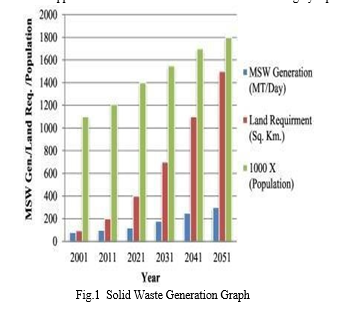
A. Overall Waste Management :-
- In 2022, Pune generates 1600 -1700 tons of solid waste per day.
- 160 trucks collect waste door-to-door, collecting an average of 198 tons per day.
- 563 containers and 116 compactor buckets dispersed around Pune.
- Ward wise average- 350 to 750 gms per capita per day.
- Construction and demolition waste generation –150-180 TPD.
- Garden waste generation – 50-60 TPD.
- Biomedical waste – 5-6 TPD.

D. Technology for Biomedical Waste Disposal :-
- Chemical-based technology :-
Low heat technologies operate between 93°C and 177°C and include microwaves and autoclaves. In autoclave, steam is used as a method for sterilization. Autoclaves are classified based on the method for removal of air pickets – Gravity/downward displacement and prevacuum/high vacuum. Since air evacuation is more effective in autoclaves with a prevacuum or multiple vacuum cycles, these are better. A shredder or grinder should be used if waste is to be made unrecognizable or reduction in waste volume is needed. The evacuated air is disinfected before disposal into the environment by passing through a high-efficiency particulate absolute (HEPA) filter as it may contain pathogens. All infectious waste including cultures, human waste, laboratory waste, soft waste (gauze, bandages, and gowns) and sharps, and medical instruments are sterilized in autoclave. Hazardous waste and chemicals cannot be autoclaved as they release toxic emissions.
2. The chlorine-based system :-
It uses sodium hypochlorite or chlorine dioxide. Sodium hypochlorite was one of the first chemical disinfectants used to treat BMW. Lately, it has been shown that toxins such as dioxins, halo acetic acid, and chlorinated aromatic compounds are released where sodium hypochlorite is used. Chlorine dioxide is unstable, so it is generated and used on-site. It is a strong biocide. It decomposes to form salt, less toxins are produced with its use, and it does not react with ammonium or alcohol.
3. Nonchlorine-based systems :-
These technologies use either gas, liquid, or dry chemical to treat BMW. Many of such system have come in market and few are discussed here. The SteriEcocycle 104 uses a portable chamber for collecting waste into which a peracetic acid-based decontaminant vial is added. After 10–12 min, peracetic acid disinfects the waste and aerosolized pathogens are prevented from escaping by use of HEPA filter. The liquid effluent is discharged into sewer and the waste goes as regular rash.
4. Biological methods :-
It used for disposal of BMW include an emerging system called “Bio-converter” 9 Biomedical Disposal, Inc.). It uses a solution of enzyme to decontaminate medical waste, and the resulting sludge is put through an extruder used to remove water for sewage disposal and the solid waste is sent to landfill. Another method of environmental BMW disposal is the use of biodegradable plastics. Many biomedical implants built with biodegradable plastics undergo biological degradation with microbial extracellular enzymes.
5. Construction & Demolition Waste :-
Waste Management Plans for construction, renovation and demolition projects are part of a growing movement to better manage materials and create sustainable communities. Building and demolition activities are integrating "sustainability" or "green" management techniques designed to protect the environment, save resources (including financial resources), and conserve energy to ensure the well being of current and future generations.
PMC generates approximately 250 MT per day of C&D waste from various sources.
To address the C&D waste, PMC has
- PMC has prepared a DPR to understand quantity, quality and sources of C&D waste
- Consultation with various stakeholders and understanding their concerns
- Developed separate tenders for collection and transportation as also for processing and disposal of C&D waste
- District administration has already allocated 2 acres of land at Wagholi for C&D waste processing.
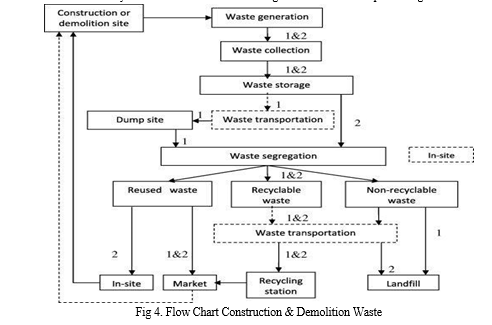
Waste management plans for construction and demolished material waste:-
A construction or demolition waste management plan does not need to be lengthy or complicated to be effective. Preparing a plan consists of identifying the types of debris that will be generated by the project and identifying how all waste streams will be handled. A successful waste management plan will contain the following information:
- Waste recycling, salvage or reuse goals
- Estimated types and quantities of materials or waste generated from the project site
- Proposed and intended disposal methods for these materials
- Intended procedures for handling the materials or waste
- Detailed instructions for the subcontractors and laborers on how to separate or collect the materials at the job site.
The industry average for waste generated at new construction sites is six pounds per square foot. Most of this waste can be put towards another use, or better yet, be recycled if proper planning is done within the design phase. The primary objective of these plans are to initially reduce the amount of generated construction waste on projects by requiring all subcontractors and material suppliers to limit quantities of materials and packaging to only those necessary for the project itself.
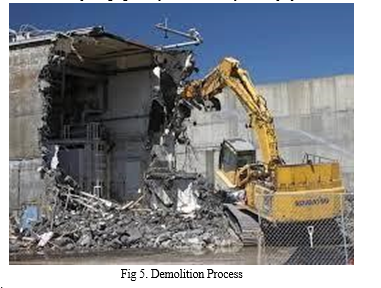
F. E-Waste Management :-
presently e waste processing in India and Pune is managed by very well networked informal sector. Defined as the waste generated from used electronic and electrical appliances which are not for their intended use. E waste is classified as a hazardous waste because it contains many toxic ingredients including halogenated compounds PCBs and heavy metals. Presently collected by bhangarwallas and scrap shops around the city it makes its way to scrap markets. Collection, segregation, dismantling reuse, recycle refurbishment, export, open burning and land
Pune region, which includes Pune city, Pimpri Chinchwad, the cantonment areas around Pune and the IT belt in Hinjewadi, generates around 10,000 MT per annum.
PMC has undertaken the following activities to tackle the situation -
- Formation of core committee
- Review of activities according to work packages
- Conducted a study through their field staff to understand how scrap shops in the informal economy deal with E waste
- Designed printed and distributed IEC material
- Various workshops organised for awareness of citizens, students and waste generators
- Tie up with formal recyclers
- E-waste collection drives, 'V collect', are organised by PMC
- An authorised E-waste collection centre at Kothrud is functional
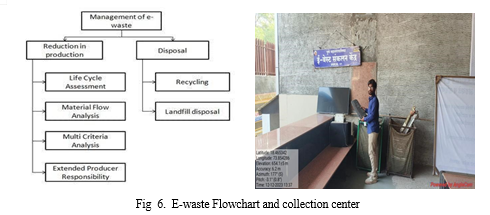
Process Of E Waste Management :-
- Collection :-
First and foremost, e-waste does not belong to general waste. When disposing of e-waste, you need to bring it to a designated collection place, usually a special recycling bin, a certified collection site, or major electronics retailers. Always check for rules that are valid in your country. Find out more tips for proper e-waste recycling when you move.
Collecting electronic items via recycling bins, take-back programs, collection locations, or ondemand collection services is the first step in the e-waste recycling process. After that, the mixed ewaste is sent to specialized electronics recyclers.
At this step, best practice demands that e-waste is divided by kind, so many collection sites will still have multiple bins and boxes for different things. This is especially critical for e-waste which requires extra handling such as batteries and can cause significant damage if mixed with other rubbish.
2. Sorting, dismantling, and shredding :-
The first step in processing e-waste involves manual sorting to extract specific items, such as batteries and bulbs, for their own processing. During this stage, certain items may be dismantled by hand to recover valuable materials or components for reuse.
After manual sorting, e-waste is shredded into small pieces to facilitate the precise sorting of materials. This is a critical stage of the process since electronics typically consist of various materials that can be separated mechanically when broken down into centimeter-sized pieces.
3. Mechanical separation :-
The mechanical separation of materials involves multiple sequential processes, with magnetic separation and water separation being the primary steps.
a. Magnetic separation :-
The e-waste is shredded and subjected to magnetic separation to extract ferrous metals like iron and steel, while non-ferrous metals are separated using eddy currents. These metals are then sent to specialized recycling facilities for smelting. Other materials, such as circuit boards and metalembedded plastic, are separated during this stage.
b. Separation by water :-
After magnetic separation, the remaining solid waste primarily consists of plastic and glass. To further purify the waste and separate different types of plastic, water is used in a subsequent separation step. Obvious contaminants are also hand-sorted during this process.
c. Plastic Waste :-
PMC has undertaken - Plastic products have become an integral part of our daily life encouraging its production. 70% of this production is converted to waste. To address this problem and make Pune a plastic waste free city or zero plastic waste i e no plastic to land.
- Preparation of a Plastic Waste Management Plan for the city in keeping with Plastic Waste Management Rules 2016 based on the principle of 'Extended Producers Responsibility'- ( Attachment – PDF presentation)
- Conducted Consultative workshops with Stakeholders
- 200 material recovery centres, to Reduce, Reuse, Recycle and Recover 170 to 180 MT of plastic waste it generates per day
- PET bottle crushing machines at 20 locations with high pedestrian footfalls
- Toll free number 1800233 3232 where citizens can call and inform regarding the recyclable waste.

4. Collecting and sorting plastic waste :-
The 3,000 SWaCH waste pickers are integrated into the door-to-door waste collection. The collected recyclable items (including plastic waste) are segregated manually by the waste pickers on the premises of a waste generator, in sorting sheds, in the open or wherever they can find a space. The SWaCH waste pickers receive income from the payment of the user fee from households and from the recyclable materials they sell to itinerant buyers and scrap shops. The non-affiliated itinerant waste pickers (approximately 4,000 of them) collect recyclable items from businesses, the streets and dump sites. They earn revenue only from the sale of these itemsThe waste pickers have a crucial role in plastic recycling because the collection and segregation of the plastic waste is mainly carried out by them. The waste pickers are able to collect and segregate various plastic types from different sources, such as households, slums, the commercial sector, streets and landfills, which conventional waste collection systems are not able to carry out. For example, the SWaCH waste pickers collect 30,000 tonnes of plastic waste per year, of which 15,000 tonnes is segregated and sent to recycling. There were no available data about the contribution of non-SWaCH waste pickers, but presumably they are also segregating plastic waste.
5. Trade and preprocessing :-
The next link in the value chain are the scrap shops that purchase small quantities of recyclable material from waste pickers or directly from households. There are approximately 600 small and medium-sized scrap shops, 50 large scrap shops and 30 larger wholesalers and aggregators in the Pune area. Most of the small and medium-sized scrap shops belong to the informal or unofficial waste sector because they are individually owned proprietorships without any waste-specific registration from the PMC or the State Pollution Control Board.
Typically, the owners of scrap shops are small informal traders earning marginally more income than waste pickers, with many hailing from families of waste pickers. All categories of scrap shops rudimentarily sort and compress collected plastic waste to re-sell by weight or unit for onward processing and recycling. Sorting by polymer, colour and quality is often conducted several times and at different locations in the value chain, with varying levels of effectiveness, which influences the quality of the handled waste items at each level.
In Pune, waste collection and recycling follow a purely commercial logic – waste pickers tend to prioritize the collection of heavy-weight and low-volume plastics, such as PET, high-density polyethylene and certain types of hard plastics (polypropylene and polystyrene) that can be sold at higher value. Low-weight and high-volume plastics, such as soft-coloured low-density polyethylene (mixed men), are less valuable and are further devalued during the monsoon season because of their high moisture content. Also, some of the mixed plastic materials (mixed men, plastic chip bags and other hard-to-recycle food packages) that form a large share of the overall plastic waste do not have commercial value as a secondary raw material and therefore are usually not bought by scrap shops. This means that many plastic items and types remain uncollected and not recycled.
a. Waste Processing Plants :-
- Organic/Wet Waste Processing Plants -
- Noble Exchange Evt Sol. 300 TPD; Bio CNG. at Baner and Talegaon
- Ajinkya Biofert & Disha Waste Management 300 TPD
- Vermi – compost and compost at Hadapsar Ramp & Ram Tekdi Industrial Estate -
- Mechanical compost, Thermal compost & Microorganism 50-100TPD.
- Vermi - compost and compost at 13decentralized plants -
- Biomethanation120 TPD; Electricity and Compost at 25 Decentralized Plants
- Dry Segregated waste processing plant
- Rochem Separation Systems 300-350TPD; RDF at Ram Tekdi Hadapsar.
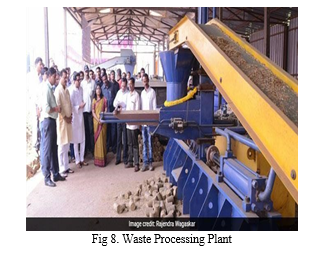
b. Materials Recovery Facility :-
Material recovery facilities are also known as Material Reclamation Facilities or Material Recycling Facilities. Material recovery facilities are designed to produce clean and pure recyclable materials to guarantee that the commodities produced are marketable and fetch the highest price.
The waste is collected from the doorstep in segregated form, which is then sorted into different categories and made into small fractions (paper, plastic, packaging paper, bottles, etc.) and sold to mediators who sell bulk materials to recyclers.
Main function of material recovery facility :-
- to maximise the number of recyclable materials from the waste generated in the municipality.
- MRFs prevent municipal, institutional, and bulk garbage from dumping in landfills.
- It assists us in protecting precious resources, reducing environmental effects, and demonstrating that waste management is no longer a burden on public authorities.
- It also extends the life of landfills, reduces environmental management efforts, and creates employment in the recycling business for the informal sector and local recyclers.

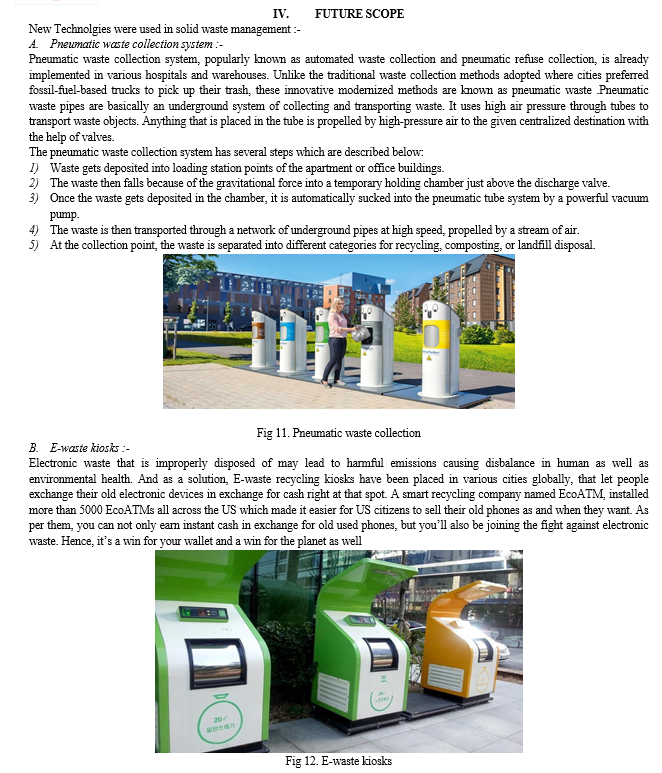
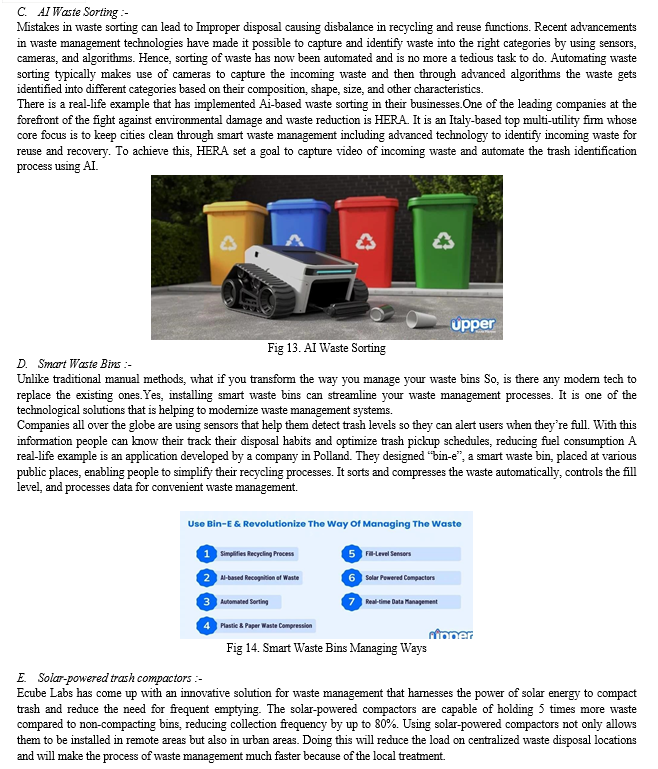

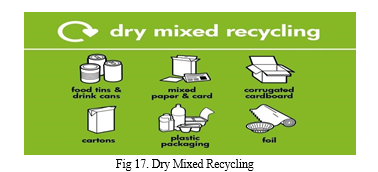
V. RESULT
Pune municipal solid waste: From the overall study of solid waste management in pune city it is observe that Pune city generates about 1600-1700 metric tones of solid waste per day. This unsegregated solid waste is disposed at landfill site near Urali-Devachi village which is 20 km away from pune city. The 43 ha of land allocated for solid waste disposal, from which 15 ha area is already land filled and sealed off permanently. Solid waste generated at disposal site is of two types biodegradable and non-biodegradable is as follows.
Characteristics of waste for pune city. Out of total garbage 70% waste is organic waste, 8% is paper waste, 7% is plastic waste, 4% metal waste, 6% glass waste, and 5% miscellaneous waste. Figure-8 Organic waste includes leaves, timber waste, vegetable extract, kitchen waste, household waste, hotels waste, fruits and juice centre residue etc. Paper waste includes paper dish, news paper, paper box, paper bags, wrapping materials (e.g. soap cover, tooth paste cover, match box cover) etc. Plastic waste includes plastic bags, broken plastic material (e.g. mug, bucket, pipes, plastic covers, plastic wrapping material). Metal waste includes screw, nut bolt, electronic parts, damage vehicle parts etc. Glass waste includes broken glass materials, bear bottle, glass lamp, bulb, tube lights. Miscellaneous waste includes all sanitary waste.
Some electronic waste contains components that can be reused again and again. We either take functional components for use in new electronic products or recycle whole, functional electronics products, e.g. monitors, memory cards, SSD hard drives, graphics cards and more.
The reuse of waste or plastic by-products produced during the manufacturing process consists of treating these materials and incorporating them back into the production process.
construction and demolition materials from disposal by practicing source reduction, salvaging, recycling, and reusing existing materials. We can also buy used and recycled products and materials. With source reduction, we can reduce the life-cycle of material use, energy use, and waste generation.
VI. DISCUSSION
Current status of the solid waste implied that the average amount of solid waste generated per capita compared to the world is much lower but the highly-dense population, makes it sever problem. The composition of the Indian solid waste mostly contains the organic substance with high moisture while other developed countries majorly generate packing waste such as paper, cardboard, plastic etc. with low moisture contents. While comparing in the Indian states and regions, waste generation pattern also varies along with quantity, quality, and typology. The high moisture content and low calorific value are mostly found common in most of the cities and states. There is a significant disparity of available resources/budget, adoption of the strategies, and planning approaches among them and which also differs from the available land, size of the required recycling and processing facilities. The significant challenge for Indian municipalities is the segregation of the waste at the source. Social taboo towards waste and its associated group mostly sub marginal people of the society has to be address prominently.
General awareness among the citizen is required towards waste management system to develop. The environment and health impact related to SWM needs to be addressed & assessed at the context. A considerable amount of finance has been already spent and without proper assessment and a holistic development plan. The government policies and their implementation not practised effectively; only a few municipalities could able to develop an effective mechanism for a door to the door collection system. Storage of solid waste is also problematic as collection vehicles are not able to collect daily.
Conclusion
In a city like Pune, where a Rag Pickers union like (KKPKP) is very strong. involvement of informal sector with ward community participation will lead to socio-economically sustainable waste management solutions. It will lead to cultivation of waste management culture in terms of waste minimization and waste recycling to next generation. It will also lead to improvement of living standards to the urban poor and will allow them to live with dignity. Involvement of private sector for their self waste management will make them responsible towards waste minimization and waste recycling and waste disposal. Any Urban Waste Management project will be successful only by participatory process of community, informal sector, private sector and proper administrative control on rest of the stakeholders. Any one stakeholder working in isolation would be a piece meal effort of Urban SWM. In cities and towns waste related issues are often mentioned as an immediate need by households and decision makers. This happens because of a number of reasons, first slum, peri-urban and low income areas do not receive any waste collection service from the municipalities. Second, waste related work is an important source of income and employment for a number of poor men and women. Third, better waste management can improve health, the living environment and can generate income for people.
References
[1] Sangram C. Patil, Milind R. Gidde 03-2023. “Smart Waste Management With 100% Door-ToDoor Waste Collection Using IOT”. Bharati Vidyapeeth (Deemed to be University) College of Engineering, Pune 43. [2] Viraja Bhat and Yogesh Patil 2021 “An Integrated and Sustainable Model for E-Waste Management for Pune City Households”. [3] Dhere Amar M., Barkade Jagnnath (2016) “Recent Status of Groundwater Pollution of Municipal Solid Waste Disposal Site at Urali-Devachi Village in Pune City”. Assistant Professor, Dept. of Science, SVT College of Home Science (Autonomous), SNDT Women’s University, Santacruz (W) MumbaiM. Wegmuller, J. P. von der Weid, P. Oberson, and N. Gisin, “High resolution fiber distributed measurements with coherent OFDR,” in Proc. ECOC’00, 2000, paper 11.3.4, p. 109. [4] Shweta Thakare , Somnath Nandi (2015) “Study on Potential of Gasification Technology for Municipal Solid Waste (MSW) in Pune City”. Department of Technology, Savitribai Phule Pune University, Ganeshkhind, Pune – 411007 [5] Ajaykumar Soni,,Deepak Patil,, Kuldeep Argade (2015) ‘Municipal Solid Waste Management International Conference on Solid Waste Management”. [6] Abhijit D. Garada ,Dr. S. B. Thakare (2015) “Solid Waste Analysis and Proposed management Plan Pune”. [7] Shibha Parhi (2015) Solid Waste Management : “A Study Of Pune Municipal Corporation. Symbiosis School of Banking and Finance”. [8] Rode Sanjay (28 december 2010) “ Integrated approach to solid waste management in Pune city”. S.K.Somaiya college, Mumbai University, India [9] Nitin Mundhe, Ravindra Jaybhaye, Bhalachandra Dorik (2014) “Assessment of Municipal Solid Waste Management of Pune City using Geospatial Tools”. epartment of Geography, S.P.College, Pune Pune, India. [10] Ravindra Jaybhaye, Nitin Mundhe and Bhalachandra Dorik (2014) “Site Suitability for Urban Solid Waste Disposal Using Geoinformatics: A Case Study of Pune Municipal Corporation”, Maharashtra, India. Department of Geography, Savitribai Phule Pune University, Pune, Maharashtra, India [11] Viraja Bhat, Yogesh Patil (2013) “E-waste consciousness and disposal practices among residents of Pune city”. a Symbiosis Institute of International Business, Symbiosis International Univeristy, Hinjewadi, Pune, India [12] Purnima Chikarmane (2012) “Integrating Waste Pickers into Municipal Solid Waste Management in Pune, India”. [13] Mane T.T.1 and Hingane Hemalata N (2011) “Existing Situation of Solid Waste Management in Pune City, India”. Department of Botany, Baburaoji Gholap College, Sangvi, Pune, MS, INDIA. [14] Ranade Pinak 1 , Bapat Geeta (2011) “Estimation of Power Generation from Solid Waste Generated in Sub Urban Area using Spatial Techniques”: A Case Study for Pune City, India. entre for Development of Advance Computing (CDAC), Pune University campus, Ganeshkhind Road, Pune – 411005 (M.S), India
Copyright
Copyright © 2024 Kuril Swapnil S., Kolekar Kunal K., Dhekane Shivsharan B., Shinde Abhijeet R.. This is an open access article distributed under the Creative Commons Attribution License, which permits unrestricted use, distribution, and reproduction in any medium, provided the original work is properly cited.

Download Paper
Paper Id : IJRASET63451
Publish Date : 2024-06-24
ISSN : 2321-9653
Publisher Name : IJRASET
DOI Link : Click Here
 Submit Paper Online
Submit Paper Online

